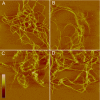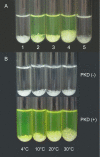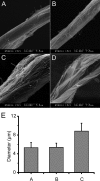Mechanistic insight into the function of the C-terminal PKD domain of the collagenolytic serine protease deseasin MCP-01 from deep sea Pseudoalteromonas sp. SM9913: binding of the PKD domain to collagen results in collagen swelling but does not unwind the collagen triple helix
- PMID: 20207733
- PMCID: PMC2863174
- DOI: 10.1074/jbc.M109.087023
Mechanistic insight into the function of the C-terminal PKD domain of the collagenolytic serine protease deseasin MCP-01 from deep sea Pseudoalteromonas sp. SM9913: binding of the PKD domain to collagen results in collagen swelling but does not unwind the collagen triple helix
Abstract
Deseasin MCP-01 is a bacterial collagenolytic serine protease. Its catalytic domain alone can degrade collagen, and its C-terminal PKD domain is a collagen-binding domain (CBD) that can improve the collagenolytic efficiency of the catalytic domain by an unknown mechanism. Here, scanning electron microscopy (SEM), atomic force microscopy (AFM), zeta potential, and circular dichroism spectroscopy were used to clarify the functional mechanism of the PKD domain in MCP-01 collagenolysis. The PKD domain observably swelled insoluble collagen. Its collagen-swelling ability and its improvement to the collagenolysis of the catalytic domain are both temperature-dependent. SEM observation showed the PKD domain swelled collagen fascicles with an increase of their diameter from 5.3 mum to 8.8 mum after 1 h of treatment, and the fibrils forming the fascicles were dispersed. AFM observation directly showed that the PKD domain bound collagen, swelled the microfibrils, and exposed the monomers. The PKD mutant W36A neither bound collagen nor disturbed its structure. Zeta potential results demonstrated that PKD treatment increased the net positive charges of the collagen surface. PKD treatment caused no change in the content or the thermostability of the collagen triple helix. Furthermore, the PKD-treated collagen could not be degraded by gelatinase. Therefore, though the triple helix monomers were exposed, the PKD domain could not unwind the collagen triple helix. Our study reveals the functional mechanism of the PKD domain of the collagenolytic serine protease MCP-01 in collagen degradation, which is distinct from that of the CBDs of mammalian matrix metalloproteases.
Figures









Similar articles
-
Hydrolysis of insoluble collagen by deseasin MCP-01 from deep-sea Pseudoalteromonas sp. SM9913: collagenolytic characters, collagen-binding ability of C-terminal polycystic kidney disease domain, and implication for its novel role in deep-sea sedimentary particulate organic nitrogen degradation.J Biol Chem. 2008 Dec 26;283(52):36100-7. doi: 10.1074/jbc.M804438200. Epub 2008 Oct 30. J Biol Chem. 2008. PMID: 18977758 Free PMC article.
-
Structural and mechanistic insights into collagen degradation by a bacterial collagenolytic serine protease in the subtilisin family.Mol Microbiol. 2013 Dec;90(5):997-1010. doi: 10.1111/mmi.12412. Epub 2013 Oct 18. Mol Microbiol. 2013. PMID: 24112706
-
A novel type of subtilase from the psychrotolerant bacterium Pseudoalteromonas sp. SM9913: catalytic and structural properties of deseasin MCP-01.Microbiology (Reading). 2007 Jul;153(Pt 7):2116-2125. doi: 10.1099/mic.0.2007/006056-0. Microbiology (Reading). 2007. PMID: 17600056
-
Matrix metalloproteinases and collagen catabolism.Biopolymers. 2002;66(1):19-32. doi: 10.1002/bip.10201. Biopolymers. 2002. PMID: 12228918 Review.
-
Thermostable Bacterial Collagenolytic Proteases: A Review.J Microbiol Biotechnol. 2024 Jul 28;34(7):1385-1394. doi: 10.4014/jmb.2404.04051. Epub 2024 Jun 17. J Microbiol Biotechnol. 2024. PMID: 38934777 Free PMC article. Review.
Cited by
-
Development of an efficient conjugation-based genetic manipulation system for Pseudoalteromonas.Microb Cell Fact. 2015 Jan 23;14:11. doi: 10.1186/s12934-015-0194-8. Microb Cell Fact. 2015. PMID: 25612661 Free PMC article.
-
Diversity, Structures, and Collagen-Degrading Mechanisms of Bacterial Collagenolytic Proteases.Appl Environ Microbiol. 2015 Sep;81(18):6098-107. doi: 10.1128/AEM.00883-15. Epub 2015 Jul 6. Appl Environ Microbiol. 2015. PMID: 26150451 Free PMC article. Review.
-
Calcium binding by the PKD1 domain regulates interdomain flexibility in Vibrio cholerae metalloprotease PrtV.FEBS Open Bio. 2013 Jun 27;3:263-70. doi: 10.1016/j.fob.2013.06.003. Print 2013. FEBS Open Bio. 2013. PMID: 23905008 Free PMC article.
-
Characterization of a New M4 Metalloprotease With Collagen-Swelling Ability From Marine Vibrio pomeroyi Strain 12613.Front Microbiol. 2020 Aug 7;11:1868. doi: 10.3389/fmicb.2020.01868. eCollection 2020. Front Microbiol. 2020. PMID: 32849455 Free PMC article.
-
Structural comparison of ColH and ColG collagen-binding domains from Clostridium histolyticum.J Bacteriol. 2013 Jan;195(2):318-27. doi: 10.1128/JB.00010-12. Epub 2012 Nov 9. J Bacteriol. 2013. PMID: 23144249 Free PMC article.
References
-
- Gluecksmann-Kuis M. A., Tayber O., Woolf E. A., Bougueleret L., Deng N., Alperin G. D., Iris F., Hawkins F. (1995) Cell 81, 289–298 - PubMed
-
- Jing H., Takagi J., Liu J. H., Lindgren S., Zhang R. G., Joachimiak A., Wang J. H., Springer T. A. (2002) Structure 10, 1453–1464 - PubMed
-
- Perrakis A., Tews I., Dauter Z., Oppenheim A. B., Chet I., Wilson K. S., Vorgias C. E. (1994) Structure 2, 1169–1180 - PubMed
-
- Orikoshi H., Nakayama S., Hanato C., Miyamoto K., Tsujibo H. (2005) J. Appl. Microbiol. 99, 551–557 - PubMed
Publication types
MeSH terms
Substances
LinkOut - more resources
Full Text Sources
Other Literature Sources
Miscellaneous

